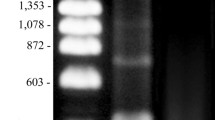Abstract
The genus Artemia (Crustacea, Phyllopoda) is widely distributed all over the world as a result partly of natural colonization and partly of spread by birds and man. Artemia offers a very interesting model for speciation studies, since the genus comprises both bisexual sibling species and parthenogenetic populations, exhibiting different chromosome numbers (diploidy, heteroploidy and polyploidy). The finding of the clustered repetitive AluI DNA family in the heterochromatin of A. franciscana can provide a useful tool for investigating the relationship between the members of the genus Artemia at the molecular level. Sixteen strains of Artemia, comprising sibling species and parthenogenetic populations, were analysed for the presence of AluI repetitive DNA by dot-blot hybridization. The observed variation in the content of repetitive DNA together with genetical, biological and geological data, support the hypothesis that Artemia living in the New World are derived from ancestral species that evolved in the Mediterranean area.
Similar content being viewed by others
References
Abreu-Grobois FA, Beardmore JA (1982) Genetic differentiation of the brine shrimp Artemia. In: Mechanisms of speciation. Liss, New York, pp 347–375
Anderson PC, Scheller RH, Posakony JW, McAllister LB, Trabert SG, Beall C, Britten RJ, Davidson C (1981) Repetitive sequences of the Sea Urchin genome. J Mol Biol 145:5–28
Barigozzi C (1974) Artemia: A survey of its significance in genetic problems. Evol Biol 7:221–252
Barigozzi C (1980) Genus Artemia: Problems of systematics. In: The brine shrimp Artemia, vol. 1, pp 147–153
Barigozzi C, Badaracco G, Plevani P, Baratelli L, Profeta S, Ginelli E, Meneveri R (1984) Heterochromatin in the genus Artemia. Chromosoma 90:332–337
Clark LS, Bowen ST (1976) The genetics of Artemia salina. J Hered 67:385–388
Dover G (1982) A role for the genome in the origin of species? In: Mechanisms of speciation. Liss, New York, pp 435–459
Gillespie D (1977) Newly evolved reported DNA sequences in Primates. Science 196:889–891
Hsu KJ, Montadert L, Bernoulli D, Cita MB, Erikson A, Garrison RE, Kidd RB, Mélières F, Muller C, Wright R (1977) History of the Mediterranean salinity crisis. Nature 267:339–403
Kafatos FC, Janes WC, Efstratiadis A (1971) Determination of nucleic acids sequence homologies and relative concentrations by dot blot hybridization procedure. Nucleic Acids Res 7:1541–1552
Maniatis R, Fritsch EF, Sambrook J (1982) Molecular cloning. A laboratory manual. Cold Spring Harbor Laboratory, NY
Meneveri R, Agersti A, Della Valle G, Talareoes D, Siccardi AG, Ginelli E (1985) Identification of a human clustered G+C rich DNA family of repeats (San 3 A family). J Mol Biol 186:483–489
Peacock WJ, Dennis ES, Gerlach WL (1982) DNA sequence changes and speciation. In: Mechanisms of speciation. Liss, New York, pp 123–142
Sanger F, Nicklen A, Coulson AR (1977) DNA sequencing with chain-terminating inhibitors. Proc Natl Acad Sci USA 74:5463–5467
Smith GP (1976) Evolution of reported DNA sequences by unequal crossover. Science 191:528–535
Southern EM (1975) Detection of specific DNA sequences among DNA fragments separated by gel electrophoresis. J Mol Biol 98:503–527
Wensink PC, Tabata S, Pachl C (1979) The clustered and scrambled arrangement of moderately repetitive elements in Drosophila DNA. Cell 18:1231–1246
Author information
Authors and Affiliations
Rights and permissions
About this article
Cite this article
Badaracco, G., Baratelli, L., Ginelli, E. et al. Variations in repetitive DNA and heterochromatin in the genus Artemia . Chromosoma 95, 71–75 (1987). https://doi.org/10.1007/BF00293844
Received:
Issue Date:
DOI: https://doi.org/10.1007/BF00293844




